Mesoscopic Fluid-Particle Flow and Vortex Structural Transmission in a Submerged Entry Nozzle of Continuous Caster
Abstract
:1. Introduction
2. Model Formulation
2.1. Lattice Boltzmann Method
2.2. Large Eddy Simulation
3. Model Setup and Validation
3.1. Calculation Details
3.2. Validation
4. Results and Discussion
4.1. Fluid-Particle Flow
4.2. Flow Structures
- (I)
- Formation of the vortices: the vortices emerge at the upper corner of the SEN. The area of a flow suddenly increases in channels, and separate at the boundary layer;
- (II)
- Development of the vortices: the size of the vortices increases gradually. The vortices develop along with the exit port and produce more vortices inside the SEN;
- (III)
- Dissipation of vortices: the vortices interact with each other and disappear inside the SEN. The vortices persist for a relatively short period.
5. Conclusions
- (1)
- The accuracy of the model has been verified by comparing vortex structures and simulated velocities with published experimental values inside and outside the SEN. Comparing simulations with RANS and LBM models, the results show that the mesoscopic LBM can predict the transient fluid-particle flow along the exit port of the SEN in detail, which can better reproduce the behavior of the oscillating jet within the SEN.
- (2)
- The transient flow behavior results from the dynamic interaction of fluid-particle flow within the SEN. The velocities always exhibit strong high-frequency components. The periodic changes of mesoscopic fluid-particles flow within the SEN can be reproduced even under stable operating conditions. The visualization of internal flow within the SEN show that the LBM–LES–DPM coupled model is good at predicting the transient vortical flow within the SEN.
- (3)
- Vortex structures are of great importance to the development of turbulent flow along the exit port of the SEN. The turbulent viscosity of flow near exit output of the SEN always fluctuates at both sides of the exit port. The asymmetric viscosities at both sides become similarly mirror-like at different times. The formation, development, and dissipation of detached vortices induced by the Q-criterion that identifies vortex structures can cause oscillation of jet within the SEN.
- (4)
- There are many frequencies (between 1 Hz and 3 Hz) seen in flow oscillations along the channel of the SEN port. The oscillations are not a simple combination of modes and flow oscillations have been intensified simultaneously. The jet oscillations must originate from within the SEN interior and are intensified along the exit port.
Author Contributions
Funding
Institutional Review Board Statement
Informed Consent Statement
Data Availability Statement
Acknowledgments
Conflicts of Interest
References
- Vigolo, D.; Radl, S.; Stone, H.A. Unexpected trapping of particles at a T junction. Proc. Natl. Acad. Sci. USA 2014, 111, 4770–4775. [Google Scholar] [CrossRef] [PubMed] [Green Version]
- Yang, J.P.; Liu, Q.; Guo, W.D.; Zhang, J.G. Quantitative evaluation of multi-process collaborative operation in steelmaking-continuous casting sections. Int. J. Miner. Metall. Mater. 2021, 28, 1353–1366. [Google Scholar] [CrossRef]
- Wu, Y.; Liu, Z.; Wang, F.; Li, B.; Gan, Y. Experimental investigation of trajectories, velocities and size distributions of bubbles in a continuous-casting mold. Powder Technol. 2021, 387, 325–335. [Google Scholar] [CrossRef]
- Liu, G.; Lu, H.; Li, B.; Ji, C.; Zhang, J.; Liu, Q.; Lei, Z. Influence of M-EMS on Fluid Flow and Initial Solidification in Slab Continuous Casting. Materials 2021, 14, 3681. [Google Scholar] [CrossRef]
- Hibbeler, L.C.; Thomas, B.G. Mold slag entrainment mechanisms in continuous casting molds. Iron Steel Technol. 2013, 10, 121–136. [Google Scholar]
- Li, X.; Li, B.; Liu, Z.; Niu, R.; Liu, Y.; Zhao, C.; Yuan, T. Large eddy simulation of multi-phase flow and slag entrapment in a continuous casting mold. Metals 2019, 9, 7. [Google Scholar] [CrossRef] [Green Version]
- Zhao, P.; Li, Q.; Kuang, S.B.; Zou, Z. Mathematical modeling of liquid slag layer fluctuation and slag droplets entrainment in a continuous casting mold based on VOF-LES method. High Temp. Mater. Process. 2017, 36, 551–565. [Google Scholar] [CrossRef]
- Kuz’min, M.P.; Chu, P.K.; Qasim, A.M.; Larionov, L.M.; Kuz’mina, M.Y.; Kuz’min, P.B. Obtaining of AleSi foundry alloys using amorphous microsilica e crystalline silicon production waste. J. Aalloys Compd. 2019, 806, 806–813. [Google Scholar] [CrossRef]
- Thomas, B.G.; Yuan, Q.; Mahmood, S.; Liu, R.; Chaudhary, R. Transport and entrapment of particles in steel continuous casting. Metall. Mater. Trans. B 2014, 45, 22–35. [Google Scholar] [CrossRef]
- Dash, S.K.; Mondal, S.S.; Ajmani, S.K. Mathematical simulation of surface wave created in a mold due to submerged entry nozzle. Int. J. Numer. Methods Heat Fluid Flow 2004, 14, 606–632. [Google Scholar] [CrossRef]
- Wondrak, T.; Eckert, S.; Gerbeth, G.; Klotsche, K.; Stefani, F.; Timmel, K.; Yin, W. Combined electromagnetic tomography for determining two-phase flow characteristics in the submerged entry nozzle and in the mold of a continuous casting model. Metall. Mater. Trans. B 2011, 42, 1201–1210. [Google Scholar] [CrossRef]
- Torres-Alonso, E.; Morales, R.D.; Garcia-Hernandez, S. Cyclic turbulent instabilities in a thin slab mold. Part II: Mathematical model. Metall. Mater. Trans. B 2010, 41, 675–690. [Google Scholar] [CrossRef]
- Calderón-Ramos, I.; Morales, R.D.; Servín-Castañeda, R.; Pérez-Alvarado, A.; García-Hernández, S.; de Jesús Barreto, J.; Arreola-Villa, S.A. Modeling study of turbulent flow in a continuous casting slab mold comparing three ports SEN designs. ISIJ Int. 2019, 59, 76–85. [Google Scholar] [CrossRef] [Green Version]
- Zhang, H.; Fang, Q.; Xiao, T.; Ni, H.; Liu, C. Optimization of the flow in a slab mold with argon blowing by divergent bifurcated SEN. ISIJ Int. 2019, 59, 86–92. [Google Scholar] [CrossRef] [Green Version]
- Real, C.; Miranda, R.; Vilchis, C.; Barron, M.; Hoyos, L.; Gonzalez, J. Transient internal flow characterization of a bifurcated submerged entry nozzle. ISIJ Int. 2006, 46, 1183–1191. [Google Scholar] [CrossRef]
- Liu, Z.Q.; Li, B.K.; Jiang, M.F. Asymmetric flow and bubble transport inside a slab continuous-casting mold. Metall. Mater. Trans. B 2014, 45, 675–697. [Google Scholar] [CrossRef]
- Gonzalez-Trejo, J.; Real-Ramirez, C.A.; Carvajal-Mariscal, I.; Sanchez-Silva, F.; Cervantes-De-La-Torre, F.; Miranda-Tello, R.; Gabbasov, R. Hydrodynamic analysis of the flow inside the submerged entry nozzle. Math. Probl. Eng. 2020, 2020, 6267472. [Google Scholar] [CrossRef]
- Pirker, S.; Kahrimanovic, D.; Schneiderbauer, S. Secondary vortex formation in bifurcated submerged entry nozzles: Numerical simulation of gas bubble entrapment. Metall. Mater. Trans. B 2015, 46, 953–960. [Google Scholar] [CrossRef]
- Zhao, P.; Li, Q.; Kuang, S.B.; Zou, Z. LBM-LES simulation of the transient asymmetric flow and free surface fluctuations under steady operating conditions of slab continuous casting process. Metall. Mater. Trans. B 2017, 48, 456–470. [Google Scholar] [CrossRef]
- Zhao, P.; Yang, B.; Piao, R. Lattice Boltzmann Method Modeling of Flow Structures and Level Fluctuations in a Continuous Casting Process. ACS Omega 2019, 4, 13131–13142. [Google Scholar] [CrossRef]
- He, X.; Luo, L.S. Theory of the lattice Boltzmann method: From the Boltzmann equation to the lattice Boltzmann equation. Phys. Rev. E 1997, 56, 6811–6817. [Google Scholar] [CrossRef] [Green Version]
- Qian, Y.; D’Humières, D.; Lallemand, P. Lattice BGK models for Navier-Stokes equation. EPL Eur. Lett. 1992, 17, 479. [Google Scholar] [CrossRef]
- Smagorinsky, J. General circulation experiments with the primitive equations: I. The basic experiment. Weather Rev. 1963, 91, 99–164. [Google Scholar] [CrossRef]
- Hunt, J.C.; Wray, A.A.; Moin, P. Eddies, stream, and convergence zones in turbulent flows. In Studying Turbulence Using Numerical Simulation Databases—II; Center for Turbulence Research: Stanford, CA, USA, 1988; pp. 193–208. [Google Scholar]
- Lawson, N.J.; Davidson, M.R. Oscillatory flow in a physical model of a thin slab casting mold with a bifurcated submerged entry nozzle. J. Fluids Eng. 2002, 124, 535–543. [Google Scholar] [CrossRef]
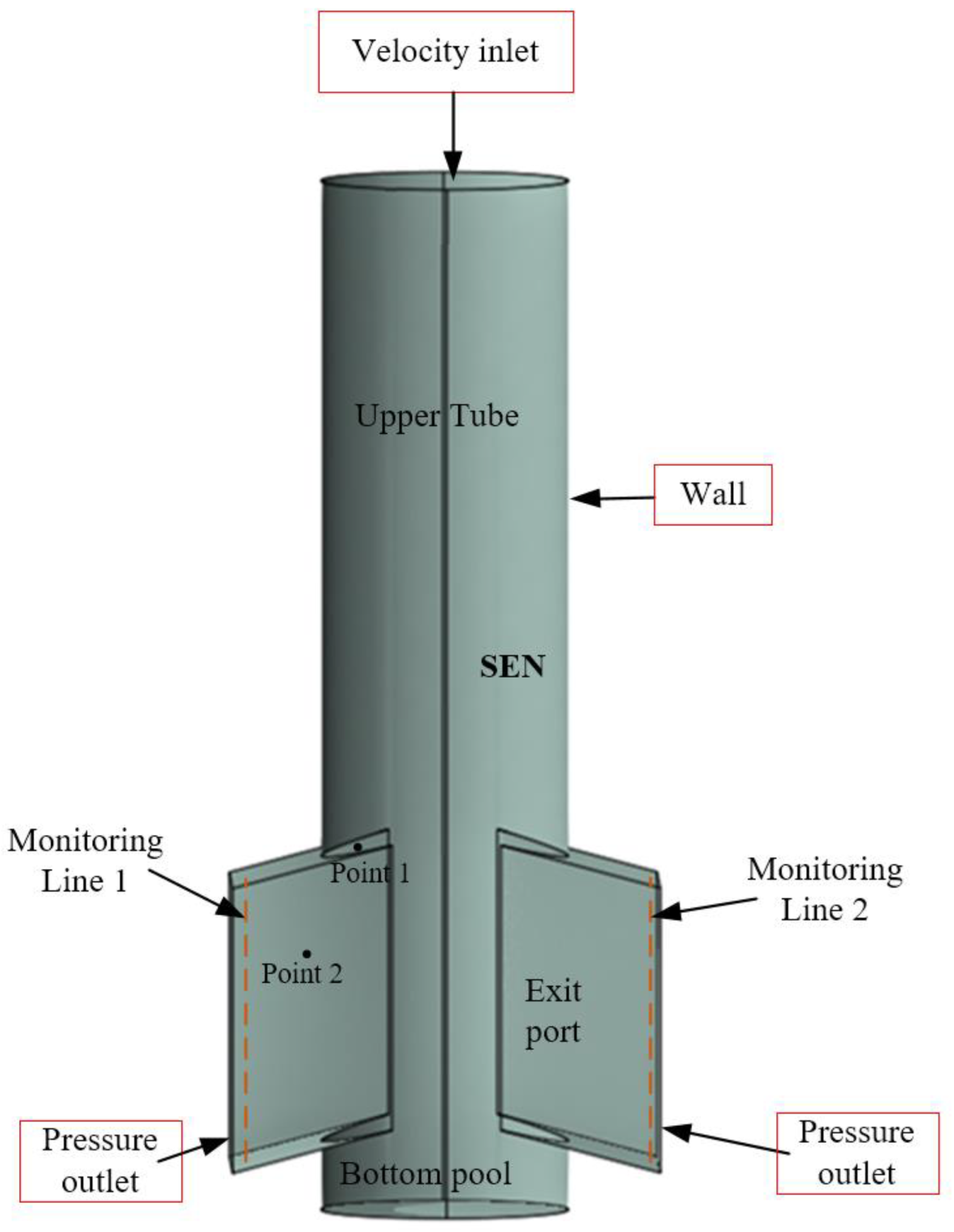

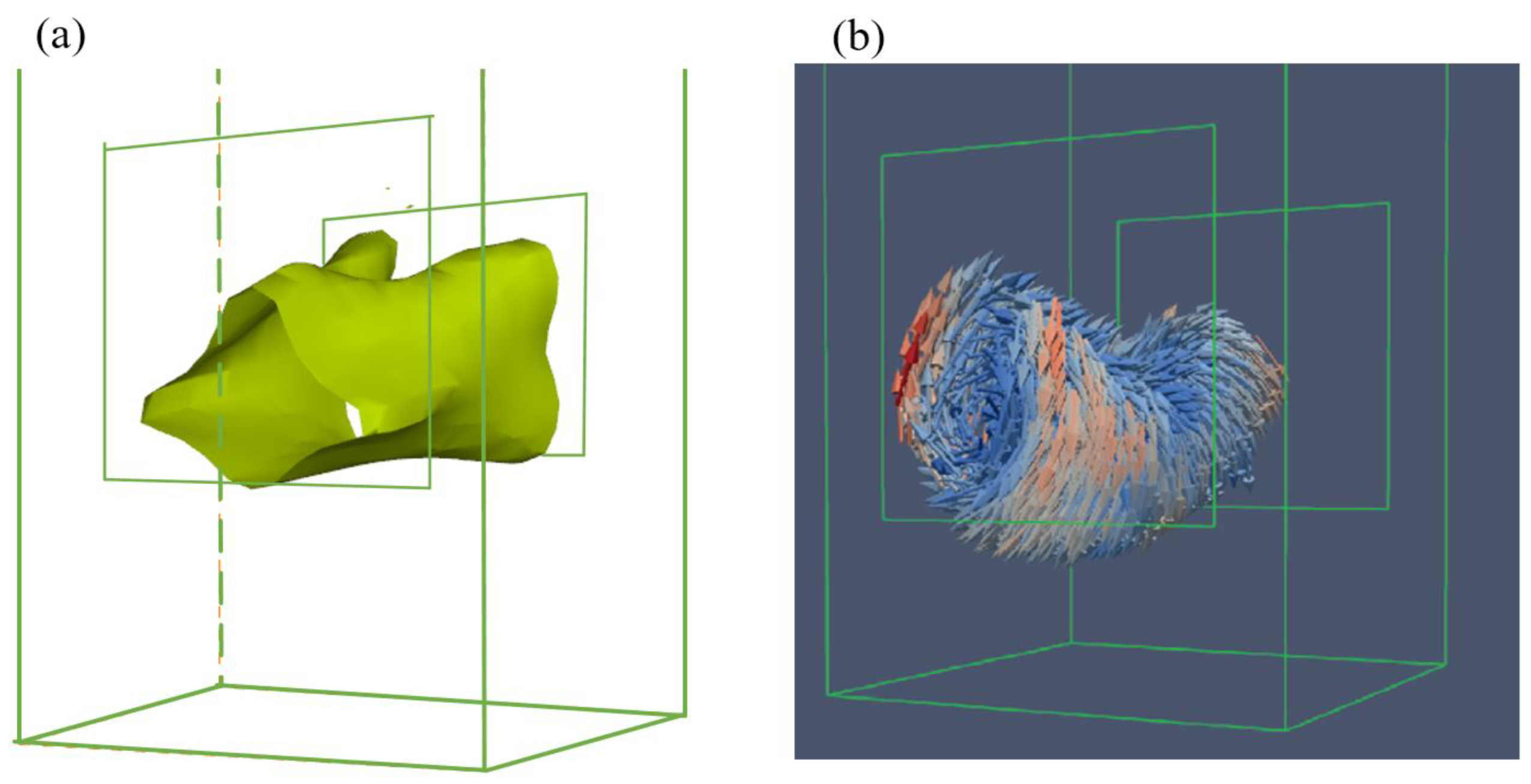
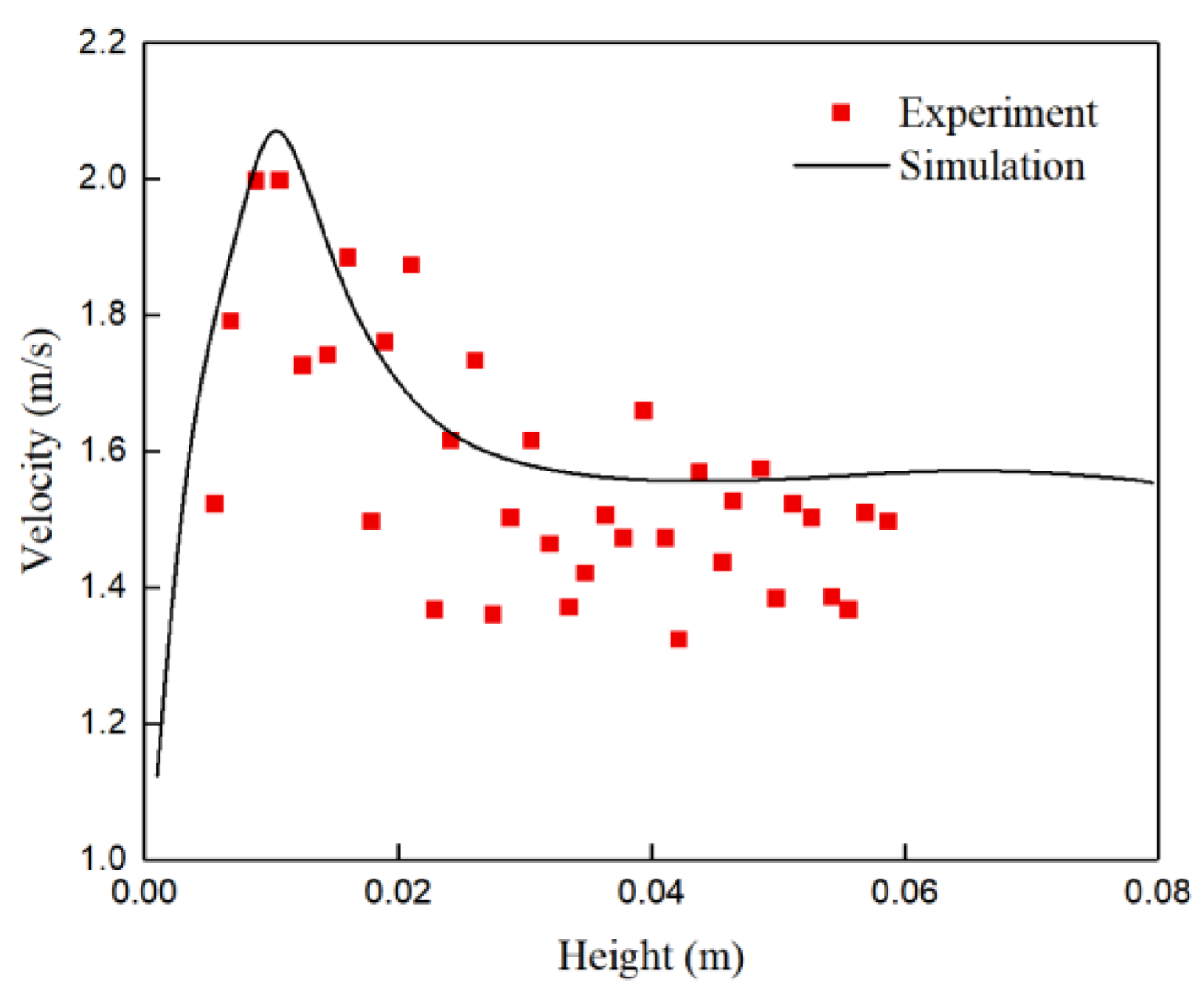

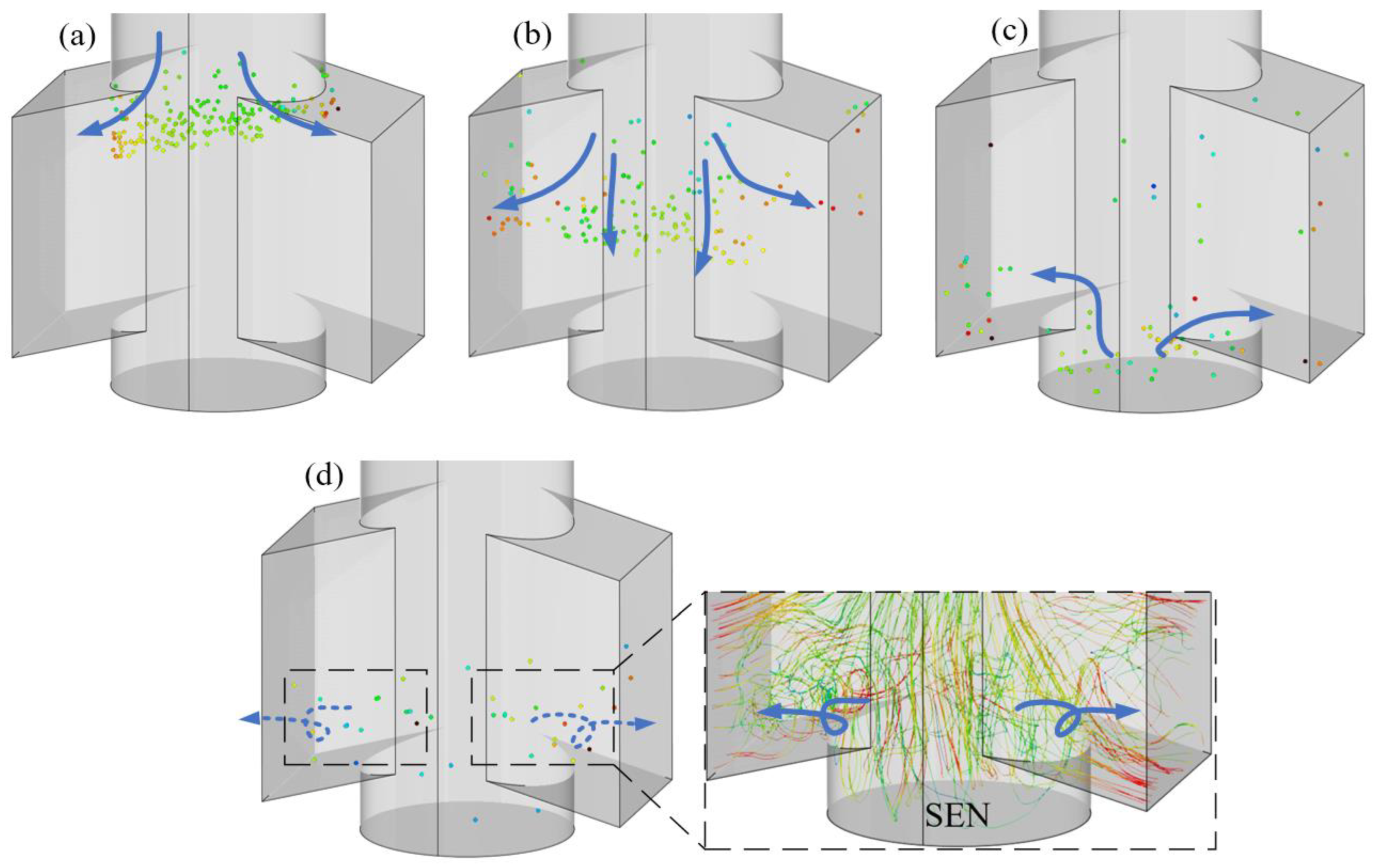
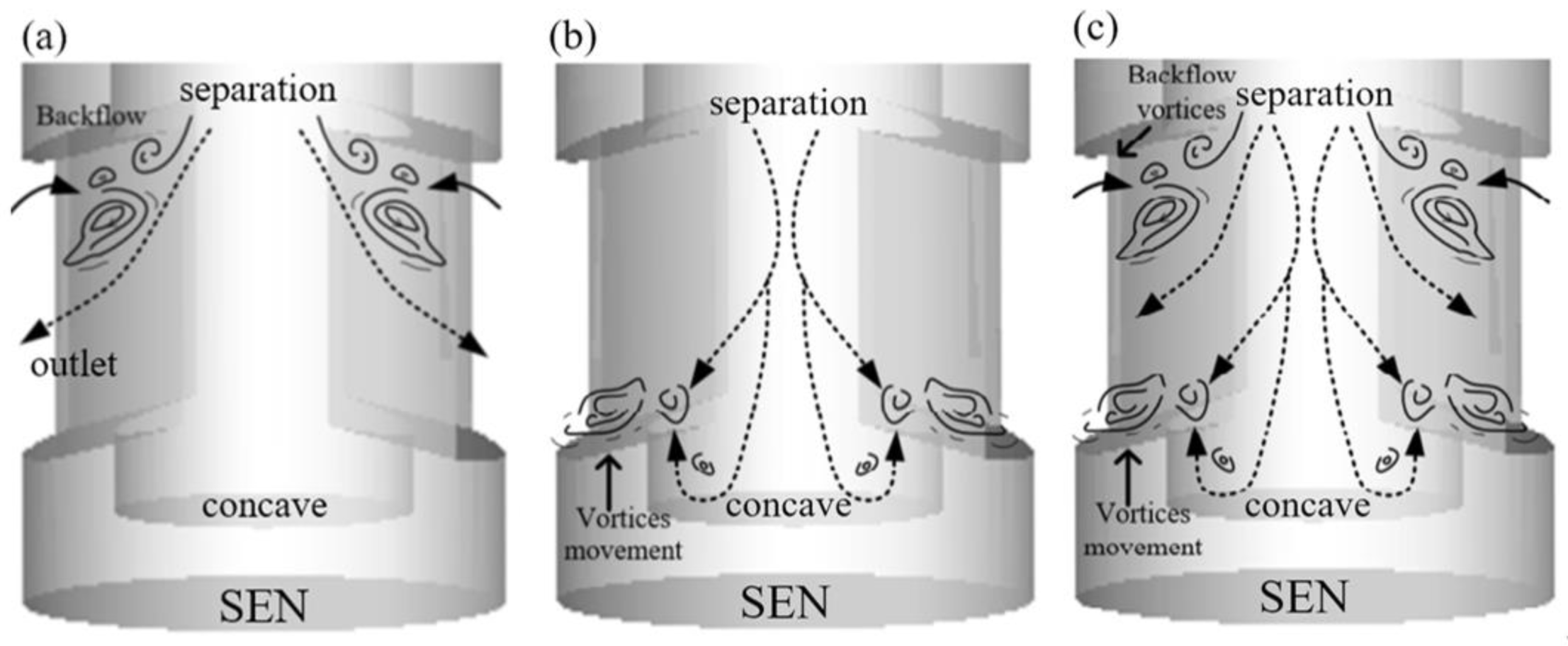

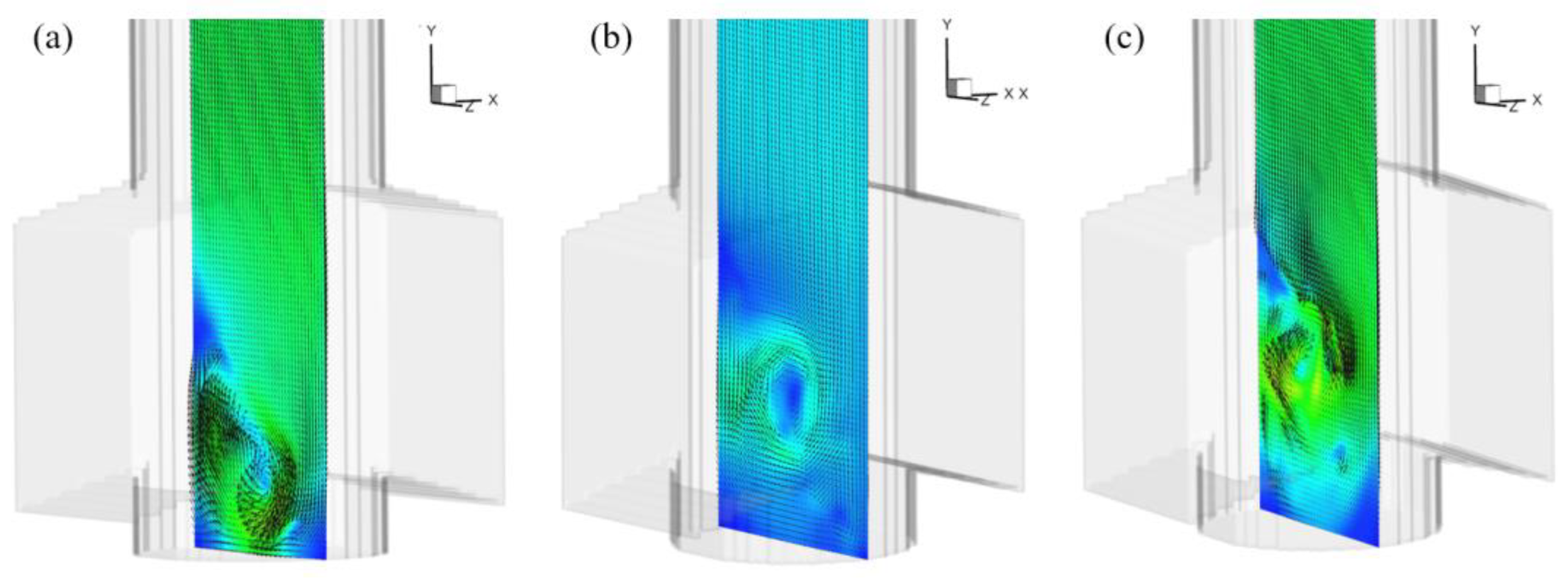

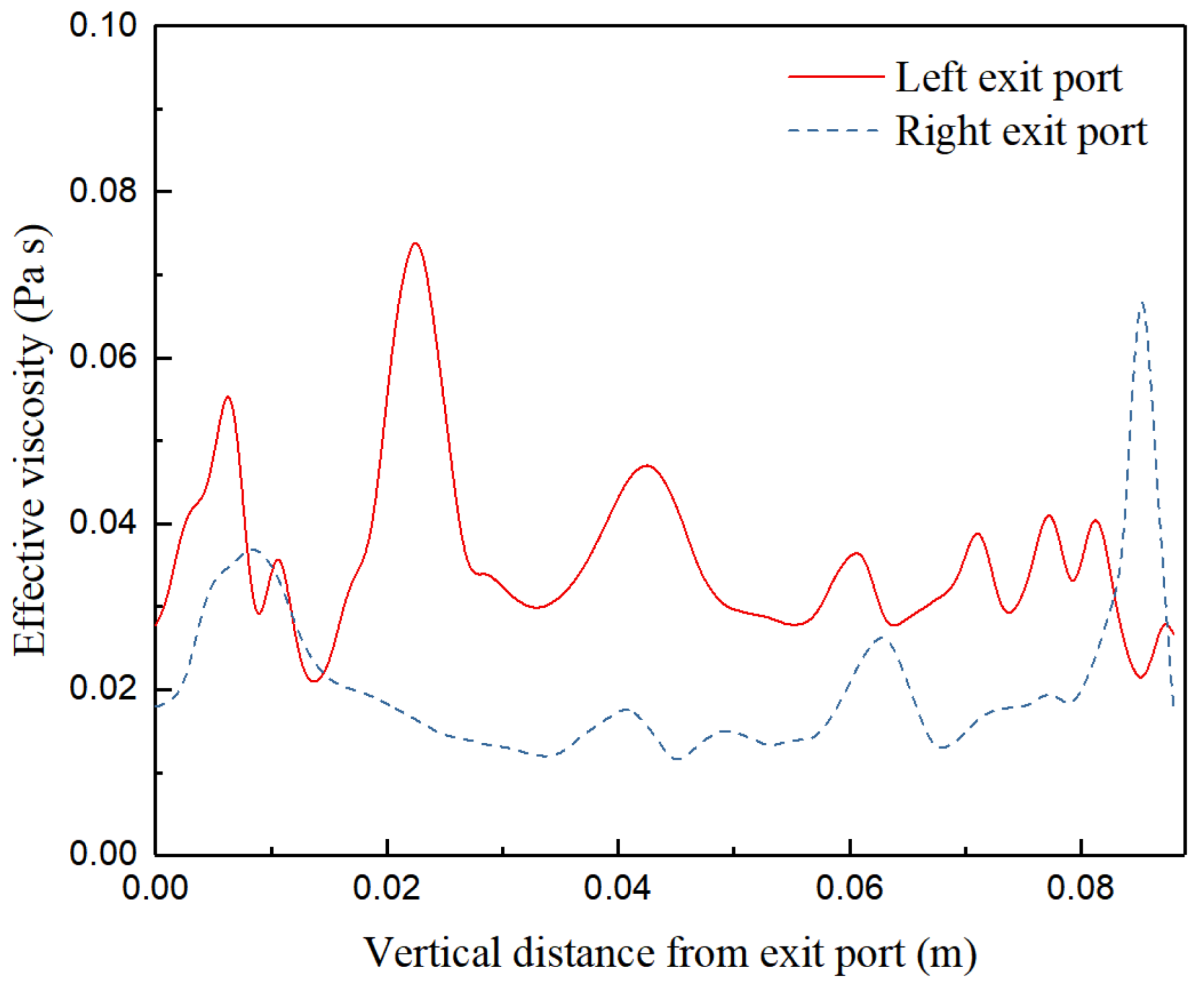

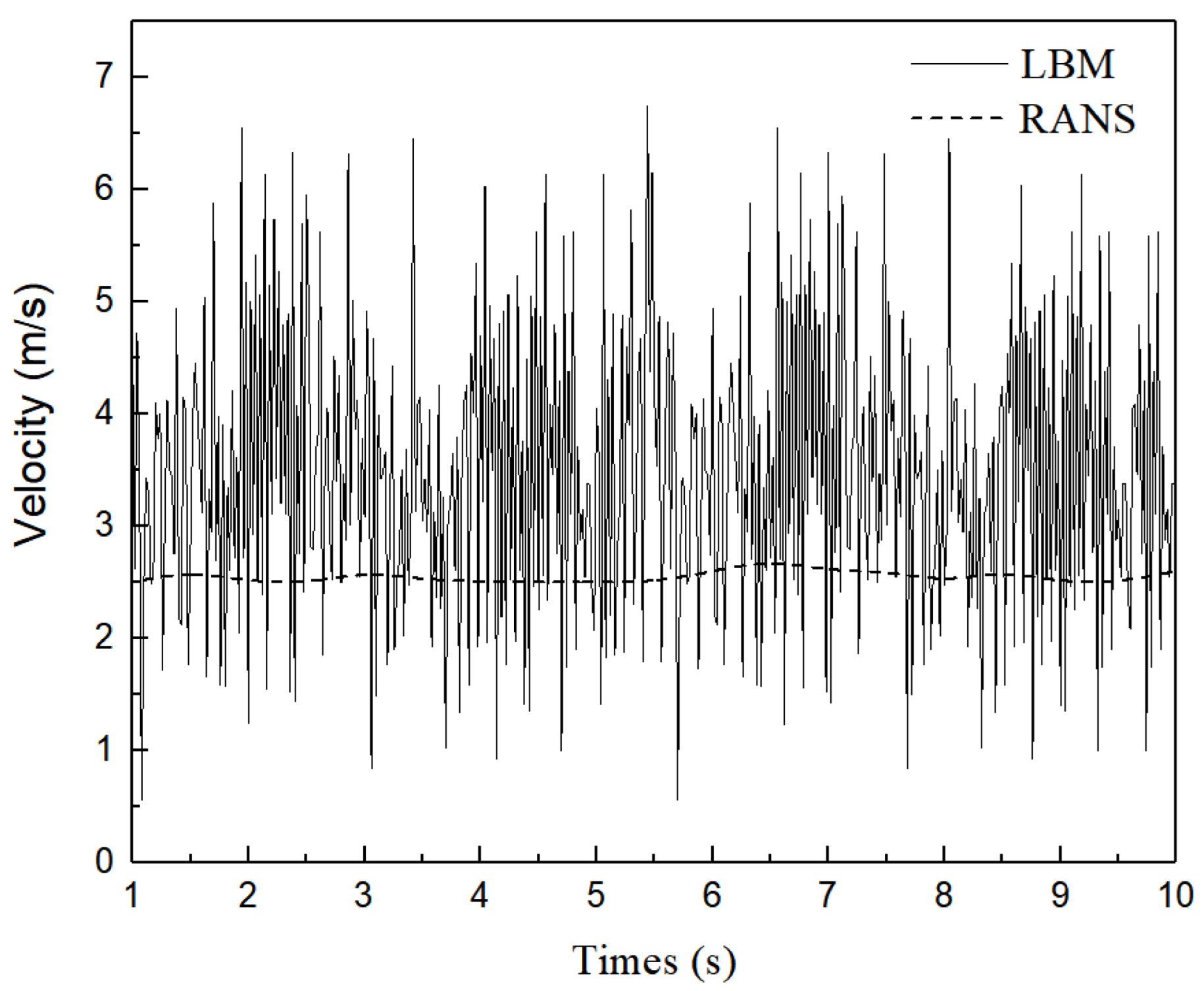
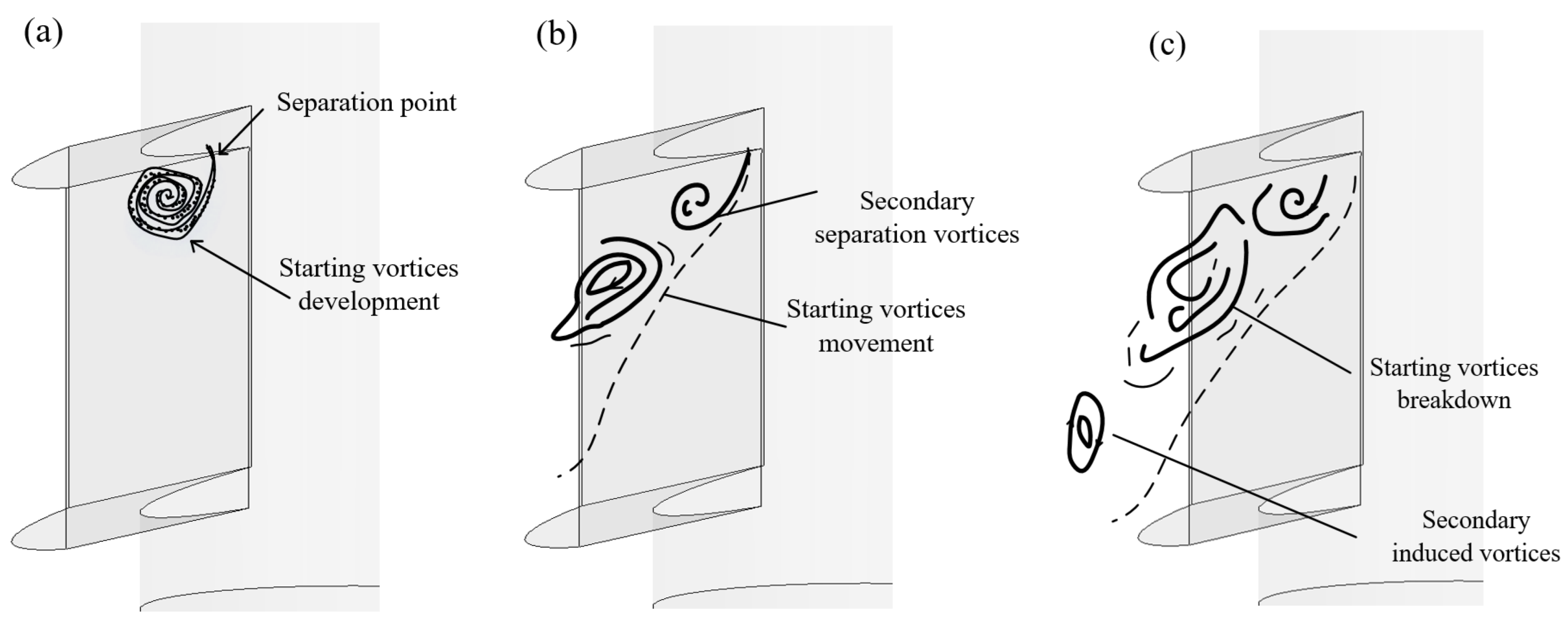
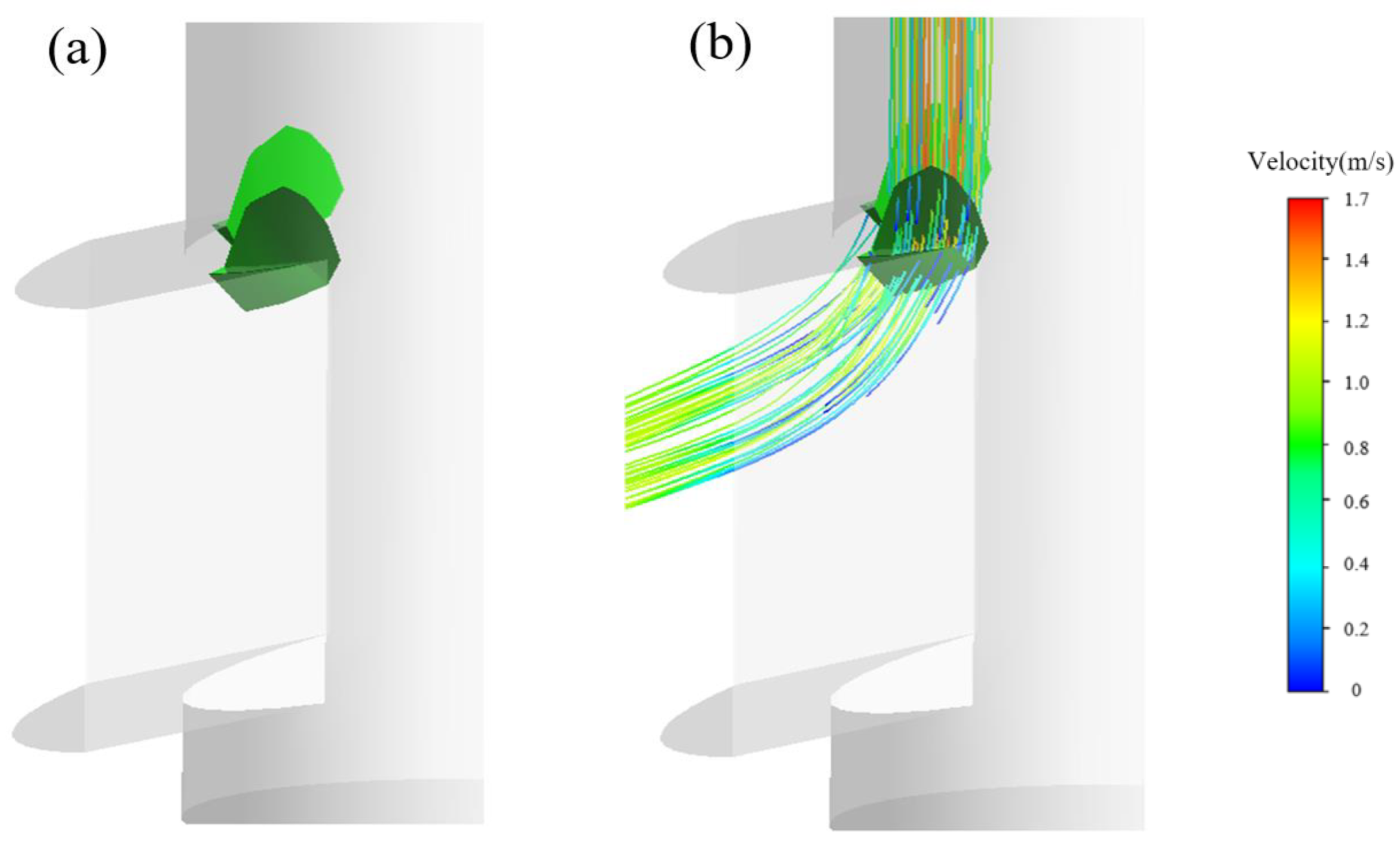
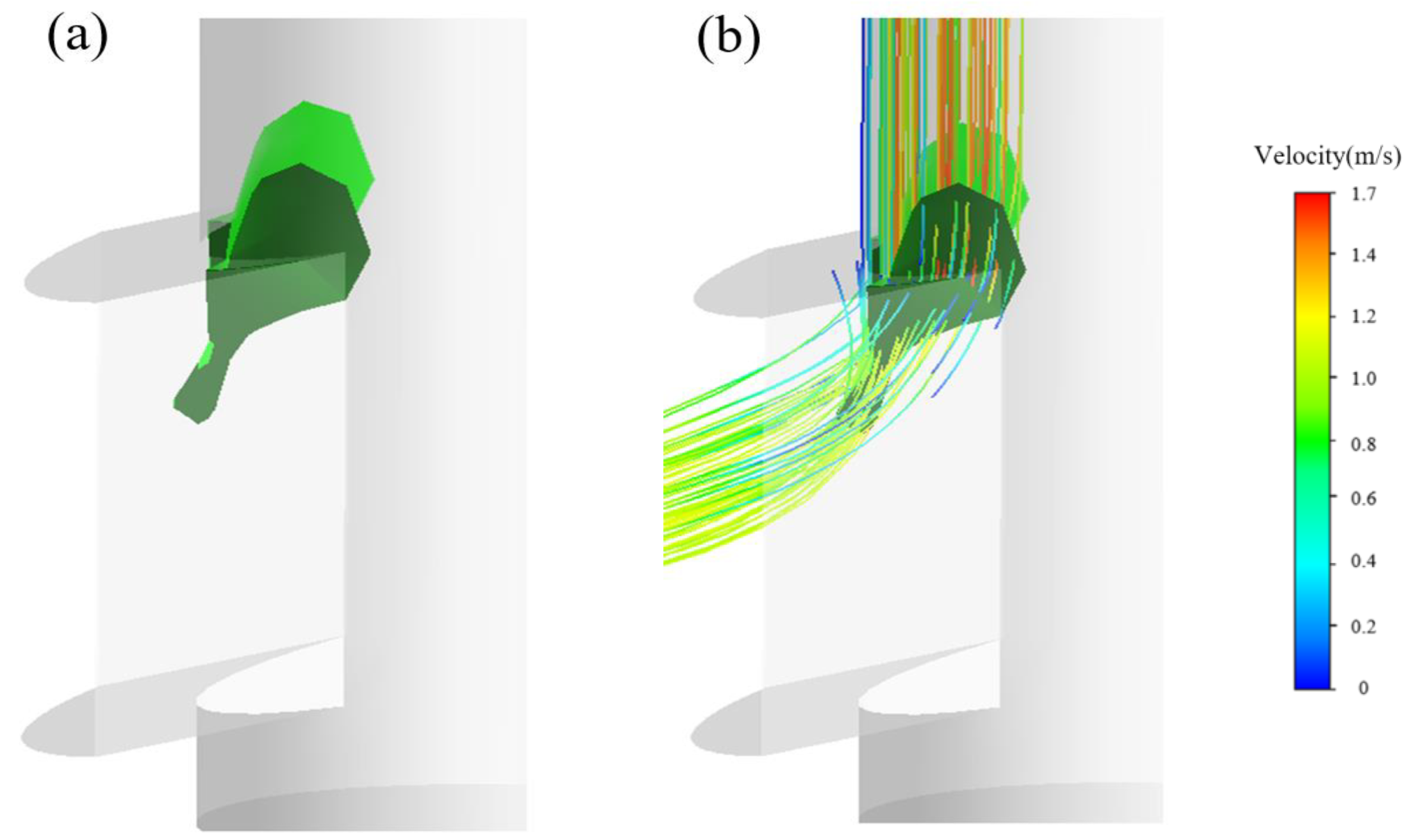
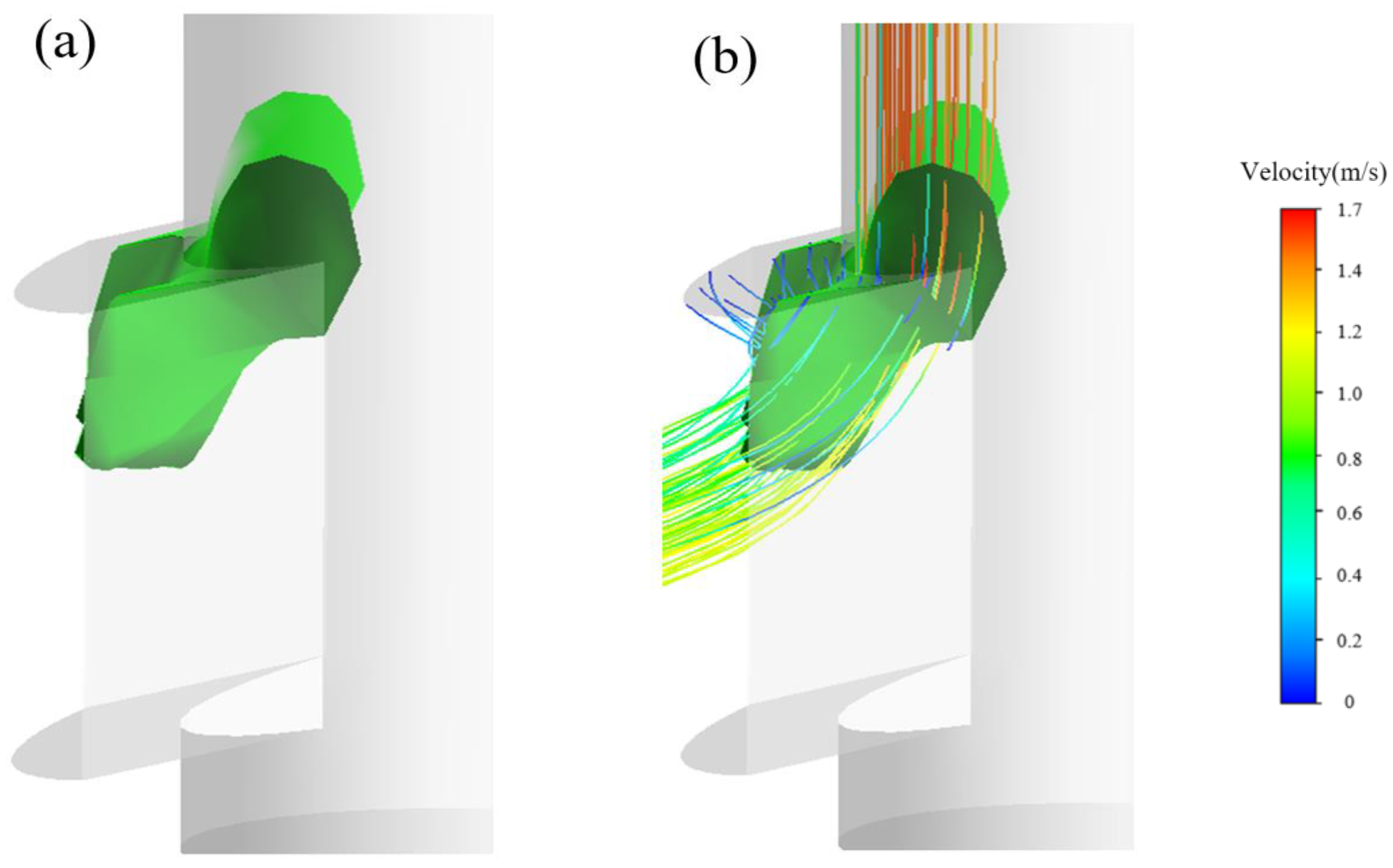
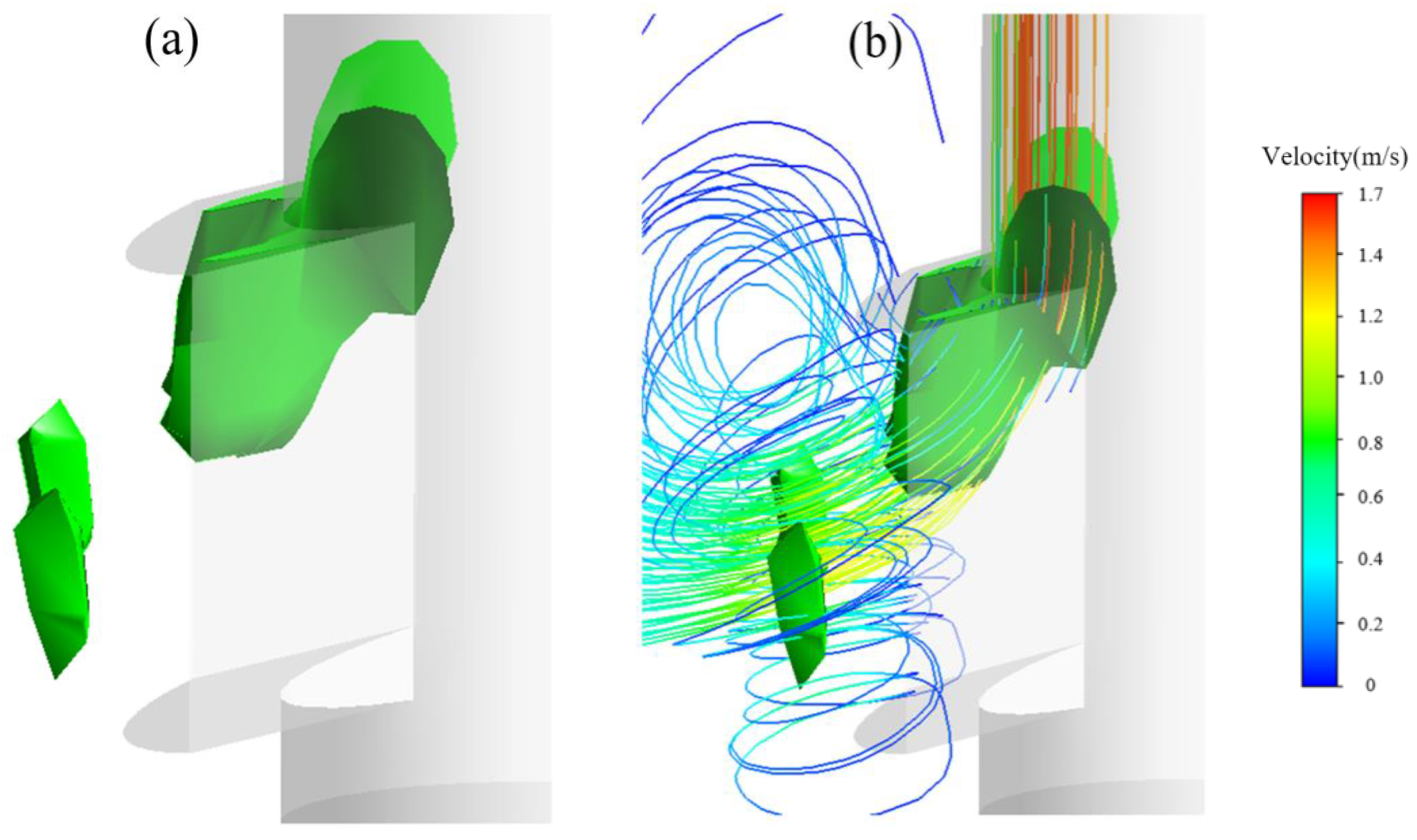
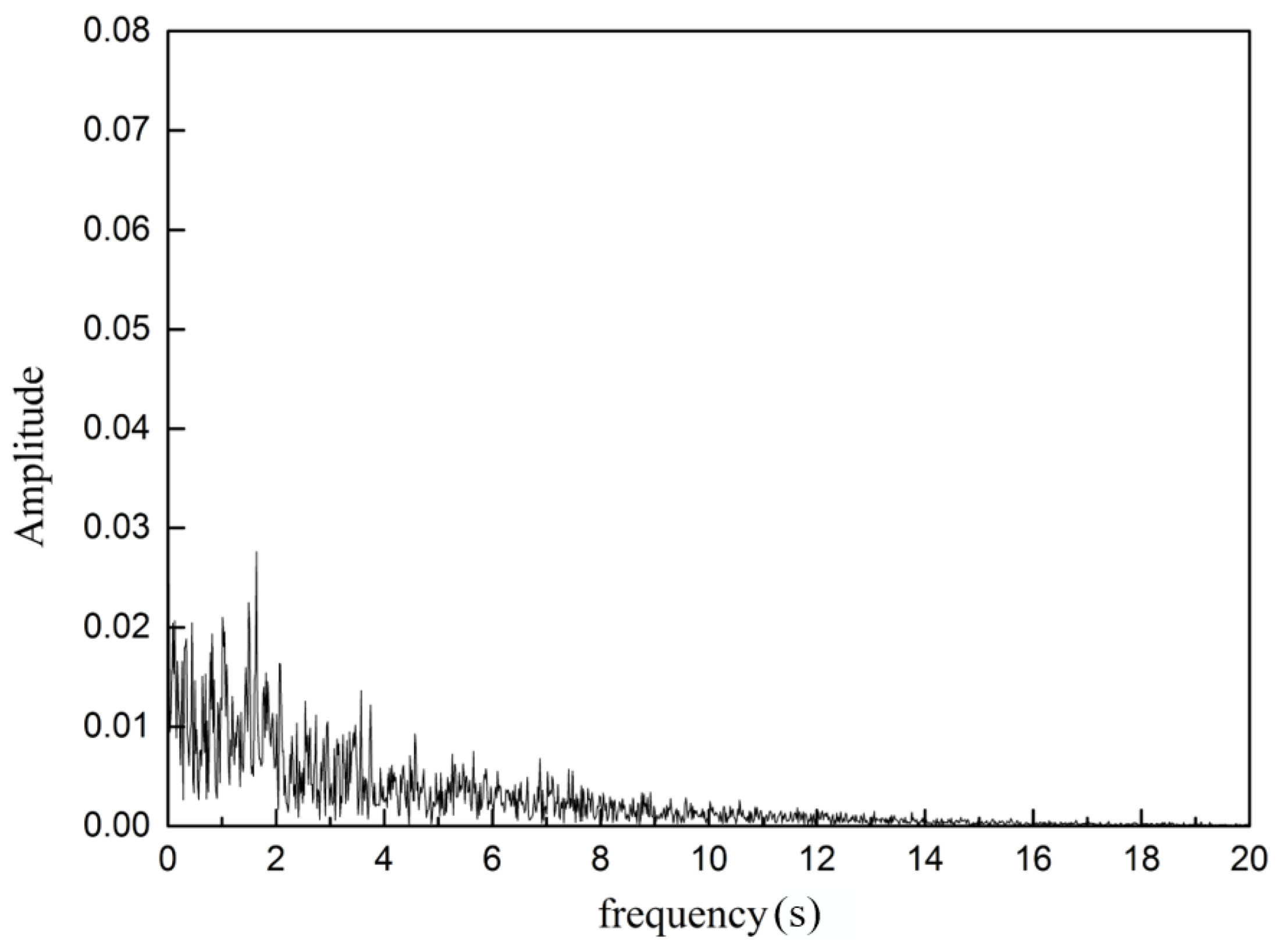
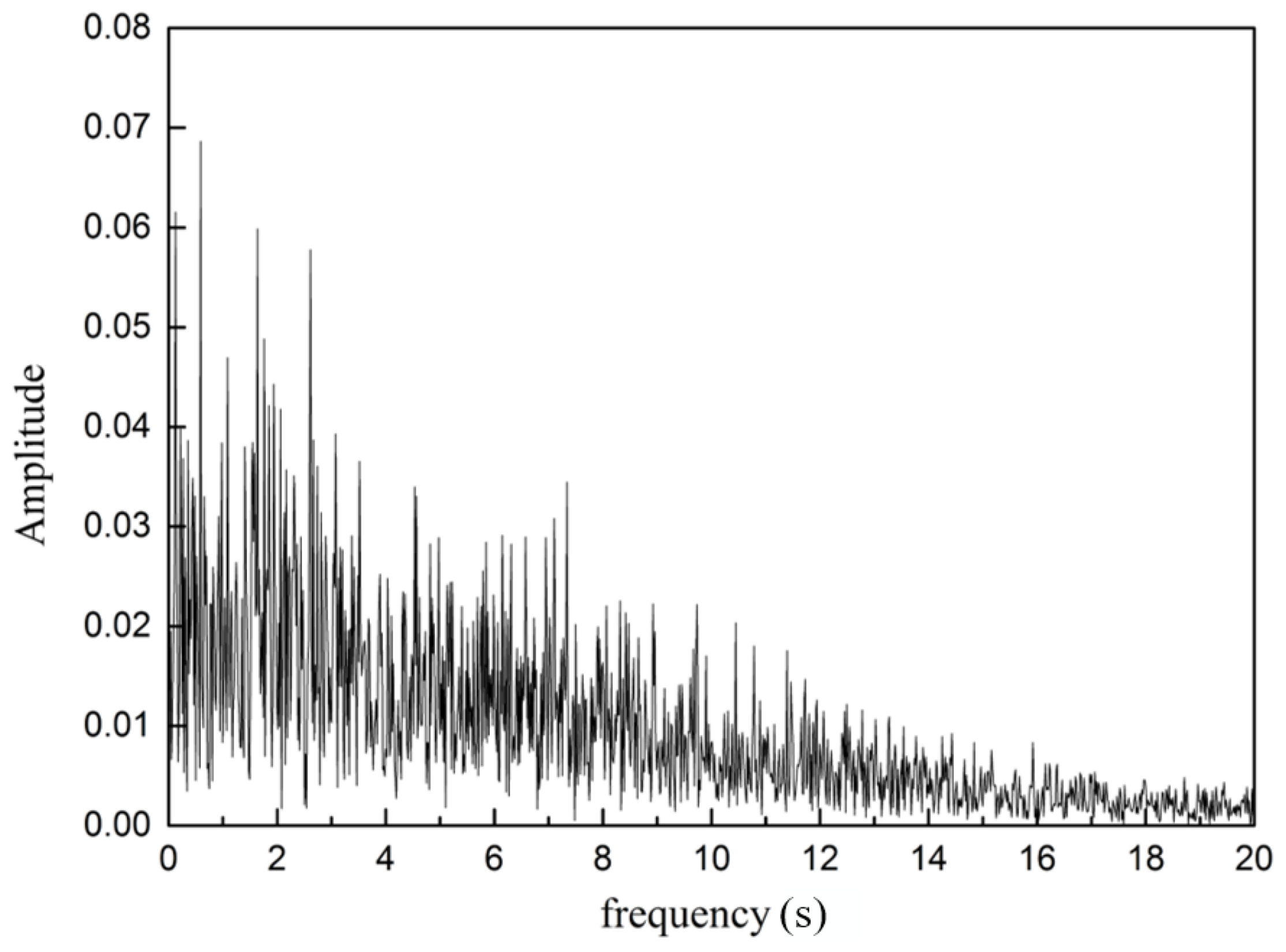
| Parameter | Value |
|---|---|
| Mold width (m) | 1.2 |
| Mold thickness (m) | 0.23 |
| Casting speed (m·min−1) | 1.3 |
| SEN submergence depth (mm) | 200 |
| SEN port angle (deg) | 15° |
| SEN port shape | Rectangle |
| SEN port height (mm) | 45 |
| SEN port width (mm) | 35 |
| Molten steel density (kg·m−3) | 7000 |
| Molten steel viscosity (Pa·s) | 0.006 |
Publisher’s Note: MDPI stays neutral with regard to jurisdictional claims in published maps and institutional affiliations. |
© 2022 by the authors. Licensee MDPI, Basel, Switzerland. This article is an open access article distributed under the terms and conditions of the Creative Commons Attribution (CC BY) license (https://creativecommons.org/licenses/by/4.0/).
Share and Cite
Zhao, P.; Piao, R.; Zou, Z. Mesoscopic Fluid-Particle Flow and Vortex Structural Transmission in a Submerged Entry Nozzle of Continuous Caster. Materials 2022, 15, 2510. https://doi.org/10.3390/ma15072510
Zhao P, Piao R, Zou Z. Mesoscopic Fluid-Particle Flow and Vortex Structural Transmission in a Submerged Entry Nozzle of Continuous Caster. Materials. 2022; 15(7):2510. https://doi.org/10.3390/ma15072510
Chicago/Turabian StyleZhao, Peng, Rongxun Piao, and Zongshu Zou. 2022. "Mesoscopic Fluid-Particle Flow and Vortex Structural Transmission in a Submerged Entry Nozzle of Continuous Caster" Materials 15, no. 7: 2510. https://doi.org/10.3390/ma15072510






